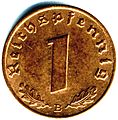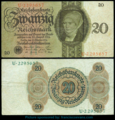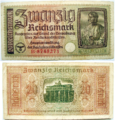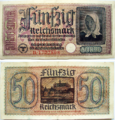Reichsmark
This article includes a list of general references, but it lacks sufficient corresponding inline citations. (February 2017) |
| |||||
| Unit | |||||
|---|---|---|---|---|---|
| Plural | Reichsmark | ||||
German Rentenmark | |||||
| Date of withdrawal |
| ||||
| Replaced by |
| ||||
| User(s) | |||||
| Issuance | |||||
Slovak koruna (1939-1945), Ukrainian karbovanets in World War II as similar rates | |||||
| This infobox shows the latest status before this currency was rendered obsolete. | |||||
The Reichsmark (German:
History
The Reichsmark was introduced in 1924 as a permanent replacement for the
Expansion outside the Reichsmark
During this period a number of shell companies were created and authorized to issue bonds outside the Reichsmark in order to finance state projects.[2] Nominally exchangeable at a 1:1 rate for Reichsmarks but then discounted by the Reichsbank this created secret monetary expansion without formally renouncing the gold standard of the Reichsmark.[3]
World War II
With the annexation of the Federal State of Austria by Germany in 1938, the Reichsmark replaced the Austrian schilling. During the Second World War, Germany established fixed exchange rates between the Reichsmark and the currencies of the occupied and allied countries, often set so as to give economic benefits to German soldiers and civilian contractors, who were paid their wages in local currency. The rates were as follows:
| Currency | Date set | Value per 10 ℛ︁ℳ︁ |
|---|---|---|
| Belgian franc | May 1940 | Fr 100 |
| July 1940 | Fr 125 | |
| Bohemia and Moravia crown | April 1939 | K 100 |
| Bulgarian lev | 1940 | Lev 333.33 |
| Danish crown | 1940 | DKr 10 |
| French franc | May 1940 | Fr 200 |
| Italian lira | 1943 | Lit 100 |
| Luxembourg franc | May 1940 | Fr 40 |
| July 1940 | Fr 100 | |
| Dutch florin | 10 May 1940 | ƒ6.66 |
| 17 July 1940 | ƒ7.57 | |
| Norwegian crown | 1940 | NKr 13.33 |
| ? | NKr 17.50 | |
Polish zloty |
1939 | zl 20 |
| Sterling (Channel Islands) | 1940 | £0 17s 4+1⁄2d |
| Croatian kuna | April 1941 | Kn 200 |
Slovak crown |
1939 | Sk 100 |
| 1 October 1940 | Sk 116.20 | |
Finnish mark |
1941 | FMk 197.44 |
Post-war
After the
Coins
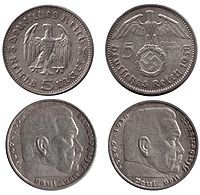



In 1924, coins were introduced in denominations of 1 ℛ︁₰, 2 ℛ︁₰, 5 ℛ︁₰, 10 ℛ︁₰, and 50 ℛ︁₰, and 1 ℳ︁ and 3 ℳ︁. The 1 ℛ︁₰ and 2 ℛ︁₰ were struck in bronze, and depicted a wheat sheaf. The 5 ℛ︁₰, 10 ℛ︁₰, and 50 ℛ︁₰ were struck in aluminium-bronze and depicted wheat stocks crossed into a stylized pattern. The two highest denominations were struck in .500 fine silver and depicted the German eagle standard. In 1925, .500 fine silver 1 ℛ︁ℳ︁ and 2 ℛ︁ℳ︁ coins were introduced for circulation, along with the first of many commemorative 3 ℛ︁ℳ︁ and 5 ℛ︁ℳ︁ coins. In 1927, nickel 50 ℛ︁₰ coins were introduced along with regular-type 5 ℛ︁ℳ︁ coins, followed by the 3 ℛ︁ℳ︁ coin in 1931.
Nazi Germany had a number of mints. Each mint location had its own identifiable letter. It is therefore possible to identify exactly which mint produced what coin by noting the mint mark on the coin. Not all mints were authorized to produce coins every year. The mints were also only authorized to produce a set number of coins with some mints allocated a greater production than others. Some of the coins with particular mint marks are therefore scarcer than others. With the silver 2 ℛ︁ℳ︁ and 5 ℛ︁ℳ︁ coins, the mint mark is found under the date on the left side of the coin. On the smaller denomination Reichspfennig coins, the mint mark is found on the bottom center of the coin.
- A = Berlin
- B = Vienna
- D = Munich
- E = Muldenhütten
- F = Stuttgart
- G = Karlsruhe
- J = Hamburg
-
Prewar bronze 1 ℛ︁₰ (reverse). Made of pure bronze
-
Prewar 5 ℛ︁₰ (reverse). Made of aluminium-bronze
-
Prewar 10 ℛ︁₰ (reverse). Struck in the same aluminium-bronze as the 5 ℛ︁₰.
-
Prewar 10 ℛ︁₰ (obverse)
4 ℛ︁₰ coins were issued in 1932 as part of a failed attempt by the
Production of silver 1 ℛ︁ℳ︁ coins ended in 1927. In 1933, nickel 1 ℛ︁ℳ︁ coins were introduced, and new silver 2 ℛ︁ℳ︁ and 5 ℛ︁ℳ︁ coins were introduced which were smaller but struck in .625 and .900 fineness so as to maintain the amount of silver. Between 1933 and 1939, a number of commemorative 5 ℛ︁ℳ︁ pieces were issued. Production of the 3 ℛ︁ℳ︁ coin ceased altogether. In 1935, aluminium 50 ℛ︁₰ coins were introduced, initially for just the one year. In 1937, nickel 50 ℛ︁₰ coins were issued and continued to be produced up to 1939, before reverting to aluminum. From 1936 on, all coins except the 1 ℛ︁ℳ︁ and the first version (1935–36) of the 5 ℛ︁ℳ︁ coin (bearing the image of the late
During World War II, bronze and aluminium-bronze coins were replaced by zinc and aluminium, with the 2 ℛ︁₰ discontinued for potential of being too easily mistaken for the 5 ℛ︁₰ when struck in the same metal. The 1 ℛ︁ℳ︁, 2 ℛ︁ℳ︁, and 5 ℛ︁ℳ︁ coins were no longer issued, replaced instead by banknotes. Aluminium
-
Wartime zinc 1 Reichspfennig (reverse)
-
Wartime zinc 5 Reichspfennig (reverse)
-
Wartime zinc 10 Reichspfennig (reverse)
-
Aluminum 50 Reichspfennig coin (reverse)
After the war, the Allies issued coins in relatively small numbers between 1945 and 1948:
- 1945–46: 1 ℛ︁₰ and 10 ℛ︁₰
- 1947–48: 5 ℛ︁₰ and 10 ℛ︁₰
These coins were issued with designs very similar to those minted in 1944–45, with the eagle changed to the pre-1935 die.
10 Reichspfennig
Mintmark below the denomination and between leaves.Lettering: 10 Reichspfennig J |
The zinc 10 Reichspfennig coin was minted by Nazi Germany between 1940 and 1945 during World War II, replacing the aluminium-bronze version, which had a distinct golden colour. It is worth 1/10 or .10 of a Reichsmark. Made entirely of zinc, the 10 ℛ︁₰ is an emergency issue type, similar to the zinc 1 ℛ︁₰ and 5 ℛ︁₰, and the aluminium 50 ℛ︁₰ coins from the same period.
Mint marks
| Mint mark | Mint location | Notes |
|---|---|---|
| A[4] | State Mint Berlin, Germany | Capital of Germany |
| B | Austrian Mint Vienna, Austria | Capital of Austria |
| D | Bavarian Central Mint Munich , Germany
|
Capital of Bavaria |
| E | Muldenhütten Mint near Dresden, Germany | Capital of Saxony |
| F | State Mint Stuttgart, Germany | Capital of Württemberg |
| G | State Mint Karlsruhe, Germany | Capital of Baden |
| J | Mint of Hamburg, Germany |
Mintage


| Year | Mintage | Notes |
|---|---|---|
| 1940 A | 212,948,000 | |
| 1940 B | 76,274,000 | |
| 1940 D | 45,434,000 | |
| 1940 E | 34,350,000 | |
| 1940 F | 27,603,000 | |
| 1940 G | 27,308,000 | |
| 1940 J | 41,678,000 |
| Year | Mintage | Notes |
|---|---|---|
| 1941 A | 240,284,000 | |
| 1941 B | 70,747,000 | |
| 1941 D | 77,560,000 | |
| 1941 E | 36,548,000 | |
| 1941 F | 42,834,000 | |
| 1941 G | 28,765,000 | |
| 1941 J | 30,525,000 |
| Year | Mintage | Notes |
|---|---|---|
| 1942 A | 184,545,000 | |
| 1942 B | 16,329,000 | |
| 1942 D | 40,852,000 | |
| 1942 E | 18,334,000 | |
| 1942 F | 32,690,000 | |
| 1942 G | 20,295,000 | |
| 1942 J | 29,957,000 |
| Year | Mintage | Notes |
|---|---|---|
| 1943 A | 157,357,000 | |
| 1943 B | 11,940,000 | |
| 1943 D | 17,304,000 | |
| 1943 E | 10,445,000 | |
| 1943 F | 24,804,000 | |
| 1943 G | 3,618,000 | Rare |
| 1943 J | 1,821,000 | Rare |
| Year | Mintage | Notes |
|---|---|---|
| 1944 A | 84,164,000 | |
| 1944 B | 40,781,000 | |
| 1944 D | 30,369,000 | |
| 1944 E | 29,963,000 | |
| 1944 F | 19,639,000 | |
| 1944 G | 13,023,000 |
| Year | Mintage | Notes |
|---|---|---|
| 1945 A | 7,112,000 | Rare |
| 1945 E | 4,897,000 | Rare |
Banknotes
The first Reichsmark banknotes were introduced by the
A newer version of 20 ℛ︁ℳ︁ note was introduced in 1939, using a design taken from an unissued Austrian S100 banknote type. 5 ℛ︁ℳ︁ notes were issued in 1942. Throughout this period, the Rentenbank also issued banknotes denominated in Rentenmark, mostly in RM 1 and RM 2 denominations.
In preparation for the occupation of Germany, the United States issued occupation banknotes dated 1944, printed by the Forbes Lithograph Printing Company of Boston. These were printed in similar colours with different sizes for groups of denominations. Notes were issued for 1⁄2 ℳ︁, 1 ℳ︁, 5 ℳ︁, 10 ℳ︁, 20 ℳ︁, 50 ℳ︁, 100 ℳ︁, and 1,000 ℳ︁. The issuer was the Alliierte Militärbehörde ("Allied military authorities") with In Umlauf gesetzt in Deutschland ("in legal circulation in Germany") printed on the obverse.
These notes were convertible to US dollars at a rate of 10:1. Seeing an opportunity to procure foreign hard currency, the
In 1947 Rhineland-Palatinate issued 5₰ and 10₰ notes with Geldschein on them.
-
20 ℛ︁ℳ︁, 1924
-
10 ℛ︁ℳ︁, 1929
-
20 ℛ︁ℳ︁, 1929
-
100 ℛ︁ℳ︁, 1935
Occupation Reichsmark

Coins and banknotes for circulation in the occupied territories during the war were issued by the Reichskreditkassen. Holed, zinc coins in 5 ℛ︁₰ and 10 ℛ︁₰ denominations were struck in 1940 and 1941. Banknotes were issued between 1939 and 1945 in denominations of 50 ℛ︁₰, 1 ℛ︁ℳ︁, 2 ℛ︁ℳ︁, 5 ℛ︁ℳ︁, 20 ℛ︁ℳ︁, and 50 ℛ︁ℳ︁. These served as legal tender alongside the currency of the occupied countries.
The coins were originally planned in great numbers of 100 million and 250 million each of the 5 ℛ︁₰ and 10 ℛ︁₰ coins respectively. The first embossing order, which was issued in April 1940, was about 40 million × 5 ℛ︁₰ and 100 million × 10 ℛ︁₰. The total amount was divided between each of the seven German mints after the embossing key of 1939. The contract was stopped in August 1940 as the Wehrmacht, which had requested the coins for Belgium and France, had no more need of it. When the embossing stopped, only Berlin ("A") and Munich ("D") produced significant quantities, but they still came to only a small extent of original production plans. The majority were melted down due to the limited supply of metal and thus, most mint marks are now quite rare (except for 1940 5 A and D, and 1940 10 A).
-
Currency of the occupied countries (1940 10 J)
-
Currency of the occupied countries (1940 5 B)
-
50 ℛ︁₰, 1938–1945
-
1 ℛ︁ℳ︁, 1938–1945
-
2 ℛ︁ℳ︁, 1938–1945
-
5 ℛ︁ℳ︁, 1938–1945
-
20 ℛ︁ℳ︁, 1938–1945
-
50 ℛ︁ℳ︁, 1938–1945

Concentration camp and POW Reichsmark currency
Various special issues of Reichsmark currency were issued for use in concentration and prisoner of war (POW) camps (Stalag). None were legal tender in Germany itself. From 1942 to 1943 tokens were struck for use within the Łódź Ghetto.[6][citation needed]
Military Reichsmark currency

Special issues of Reichsmark currency were issued for use by the Wehrmacht from 1942 to 1944. The first issue was denominated in 1 ℛ︁₰, 5 ℛ︁₰, 10 ℛ︁₰, and 50 ℛ︁₰ and 1 ℛ︁ℳ︁, but was valued at 1 military Reichspfennig = 10 civilian Reichspfennig. This series was printed on only one side. The second issue notes of 1 ℛ︁ℳ︁, 5 ℛ︁ℳ︁, 10 ℛ︁ℳ︁, and 50 ℛ︁ℳ︁ were equal in value to the ordinary German Reichsmark and were printed on both sides.
The 5 Mark note pictured, front and back, is Allied military currency ("AMC") printed at Forbes Lithograph Manufacturing Company in Boston for occupied Germany. There were different AMCs for each liberated area of Europe.[7]
See also
- Öffa bills 1932 German government promissory notes
- MEFO Financial instrument used to finance Nazi German rearmament
- AM-Mark
- Pictorial list of postage stamps in Nazi Germany
References
- ^ Reichspfennig, der [Digital German Dictionary] (in German). Retrieved 2 August 2021.
{{cite encyclopedia}}:|website=ignored (help) - OCLC 724193260.
- S2CID 154770245.
- ^ "Nazi Germany Coin Mint Marks". Archived from the original on 2017-12-11. Retrieved 2013-01-16.
- ^ "10 Reichspfennig - Germany - 1871-1948 - Numista". Numista. Retrieved 2013-01-16.
- ^ "Lodz Ghetto Token Coinage". www.pcgs.com. Archived from the original on 2018-03-01. Retrieved 2018-03-01.
- ^ "Allied Military Currency". Strictly G.I. Archived from the original on 6 January 2009. Retrieved 18 March 2015.
- Krause, Chester L.; Clifford Mishler (1991). ISBN 0873411501.
- Pick, Albert (1994). ISBN 0-87341-207-9.
Further reading
- ISBN 978-1-59420-182-0.
External links
- Weimar coins (in English)
- Third Reich coins (in English)
- Weimar coins (in Russian)
- Third Reich coins (in Russian)
- Historical Currency Conversion Tables, Reichsmarks to Dollars, 1870s–2012
| Preceded by: US$1
|
Currency of Germany (Weimar Republic borders) 1924 – 1948 Note: In parallel with Rentenmark |
Succeeded by: Trizone (later West Germany and West Berlin )Ratio: 1 Mark = 7 Rentenmark on the first 70 Rentenmark for private individuals, otherwise 1 Kuponmark = 10 Rentenmark |
| Succeeded by: Deutsche Mark tradeReason: intended to protect West Germany from the second wave of hyperinflation and stop the rampant barter and black market Ratio: 1 Deutsche Mark = 1 Rentenmark for first 600 ℛ︁ℳ︁, 1 Deutsche Mark = 10 Rentenmark thereafter, plus each person received 40 Deutsche Mark | ||
| Succeeded by: Poland Ratio: None | ||
| Succeeded by: Soviet ruble Reason: Transfer of modern Kaliningrad Oblast to Soviet Union Ratio: None | ||
| Preceded by: French franc Reason: annexation to Germany Ratio: ? |
Currency of | Succeeded by: protectorate Ratio: ? |
| Preceded by: Austrian schilling Reason: annexation to Germany Ratio: 1 Mark = 1.5 Schilling |
Currency of Austria 1938 – 1945 Note: In parallel with Rentenmark |
Succeeded by: Austrian schilling Reason: restoration of independence Ratio: 1:1 for first 150 Schilling |
| Preceded by: Czechoslovak koruna Reason: annexation to Germany Ratio: ? |
Currency of Sudetenland 1938 – 1945 Note: In parallel with Rentenmark |
Succeeded by: Czechoslovak koruna Reason: re-integration to Czechoslovakia Ratio: ? |
| Preceded by: Lithuanian litas Reason: annexation to Germany Ratio: 1 Mark = 2.5 litas |
Currency of Klaipėda (Memel) 1939 – 1945 Note: In parallel with Rentenmark |
Succeeded by: Soviet ruble Reason: re-integration to Soviet Union Ratio: ? |
| Preceded by: Danzig gulden Reason: annexation to Germany Ratio: 1 Mark = 1.43 Gulden |
Currency of the Free City of Danzig 1939 – 1945 Note: In parallel with Rentenmark |
Succeeded by: Poland Ratio: ? |
| Preceded by: Polish złoty Reason: annexation to Germany Ratio: 1 Mark = 2 złote |
Currency of Polish areas annexed by Nazi Germany 1939 – 1945 |
Succeeded by: Poland Ratio: ? |
| Preceded by: Belgian franc Reason: annexation to Germany Ratio: 1 Mark = 12.5 franc |
Currency of Eupen-Malmedy 1940 – 1945 Note: In parallel with Rentenmark |
Succeeded by: Belgian franc Reason: re-integration to Belgium Ratio: 1 Mark = 12.5 franc |
| Preceded by: Luxembourgish franc Reason: annexation to Germany Ratio: 1 Mark = 10 Franc |
Currency of Luxembourg 1940 – 1945 Note: In parallel with Rentenmark |
Succeeded by: Luxembourgish franc Reason: restoration of independence Ratio: ? |
| Preceded by: French franc Reason: annexation to Germany Ratio: ? |
Currency of | Succeeded by: French franc Reason: re-integration to France Ratio: ? |
| Preceded by: Yugoslav dinar Reason: annexation to Germany Ratio: 1 Mark = 20 dinars |
Currency of North Slovenia 1941 – 1945 Note: In parallel with Rentenmark |
Succeeded by: Yugoslavia Ratio: ? |
| Preceded by: Italian lira Reason: annexation to Germany Ratio: ? |
Currency of South Slovenia 1943 – 1945 Note: In parallel with Rentenmark |
Succeeded by: Yugoslavia Ratio: ? |
| Preceded by: Soviet ruble Reason: annexation to Romania Ratio: ? |
Currency of Transnistria 1941 – 1945 |
Succeeded by: Soviet ruble Reason: re-integration to Soviet Union Ratio: ? |



